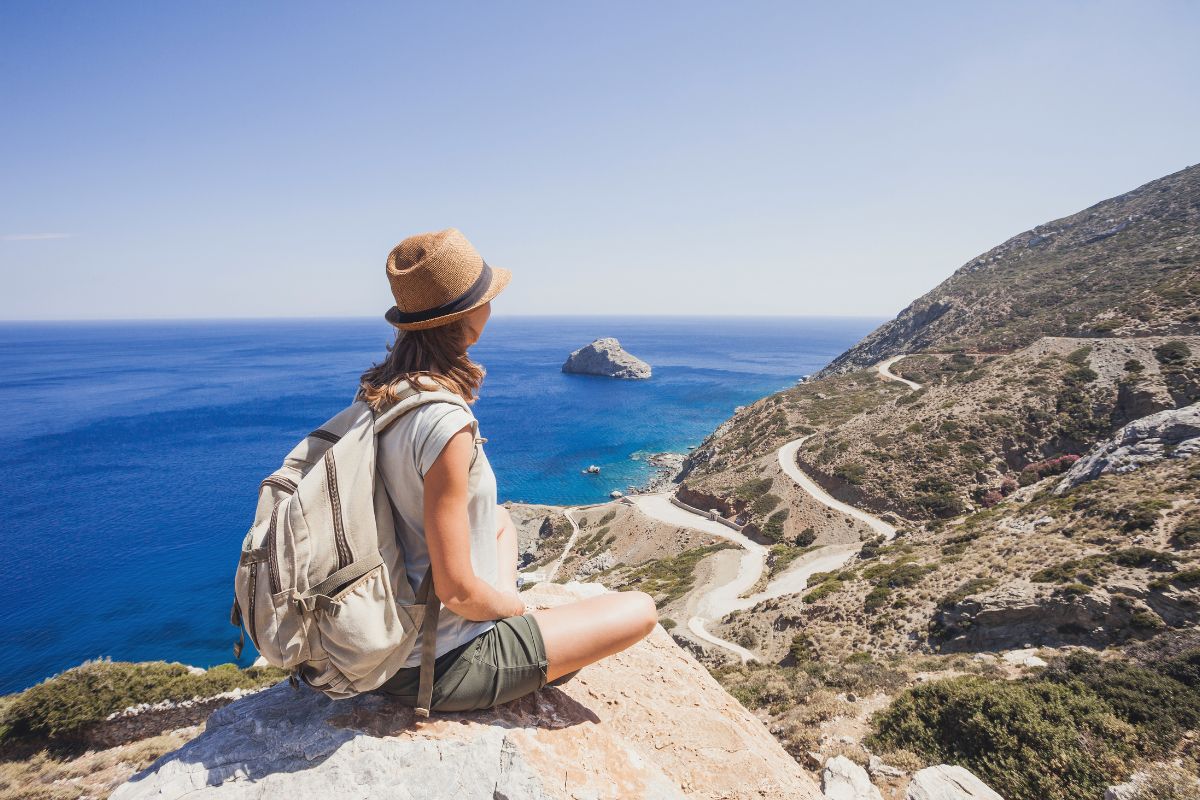Eco-Travel Lifestyle Tips for Sustainable Tourism

Travel can be good for the economy and for people, but too much tourism can hurt ecosystems and communities. More than 1.4 billion people from other countries came to visit in 2024. This rise has led to overtourism, which means crowded streets, loss of habitat, and pollution in popular places. You can help change tourism for the better by changing the way you travel to be more eco-friendly. Here are some useful recommendations for lowering your carbon footprint, choosing green transportation, packing in a way that is good for the environment, staying in eco-friendly hotels, helping local communities, avoiding overtourism, and decreasing trash when traveling. There is clear, useful advice in each part that is based on recent sources on sustainable travel.
How to Travel and Leave a Smaller Carbon Footprint
Transportation and travel decisions are the main sources of tourism emissions. Travel and tourism actually cause about 8% of all carbon emissions in the world. The major shift is to lower emissions from transportation. For instance, flying long distances releases a lot more CO₂ than riding the train or bus. Trains in Europe, many of which are electric, let off 10 times less CO₂ than a flight that is similar. A long-haul flight can put off as much pollution as a car does in a year. If you have to fly, consider nonstop flights on newer, more fuel-efficient planes and book economy class. First and business class seats take up a lot more space and fuel.
Stay longer and fly less. Do less long-distance travel and spend more time at each place. “Slow travel” is taking one longer journey instead of many short ones. This cuts down on the number of flights you take each year. If you remain longer, you may really get to know a place and avoid having to fly or drive between cities.
Make up for emissions that can’t be avoided. If you fly or drive, figure out how much carbon your journey will release and think about buying certified carbon offsets to help pay for renewable energy or reforestation programs. (Choose offset suppliers with a good reputation to make sure the money really does lower emissions.)
You can quickly lower your carbon footprint by opting to take fewer or cleaner trips. For instance, taking one rail or bus instead of separate flights can cut down on your emissions. Booking in advance and packing light (see the next part) also cuts down on the amount of gasoline burned per person.
Transportation Options That Are Good for the Environment
The way you navigate around a place can have a big effect on pollution. Planes and cars are the least efficient ways to go around, so whenever you can, choose green options:
Take trains, coaches, or buses. Overland public transportation is usually better for the environment and more enjoyable than flying. High-speed trains and long-distance coaches use a lot less gas per passenger for trips that are not too long. Once you’re in town, you can take the bus, subway, or streetcar. A lot of cities now have electric or hybrid buses. When you go by train, you can also see beautiful views and cut down on pollution.
Walk or bike: You may see neighborhoods and neighboring attractions on foot or by bike. This doesn’t release any carbon and lets you see locations at a local speed. Many cities and small towns hire bikes or have bike-share programs. Using these saves gas and is typically the quickest way to get around busy regions.
Rent cars that are good for the environment. If you have to drive, get the smallest car you need (an economy or compact car instead of an SUV). Renting a hybrid or completely electric automobile is much better. Some countries are getting electric tuk-tuks and rickshaws as a clean way to get around.
When flying or driving, always try to book direct, non-stop flights on newer planes, as these use less fuel per mile. When you can, carpool or utilize shuttles. Sharing a ride with a lot of people reduces down on the impact on each person. Also, look into your destination. Some cities have exceptionally clean public transportation, including wind-powered trains in the Netherlands and electric buses in Washington, D.C. You can cut down on tourism’s carbon impact the most by using public or active transportation and low-emission vehicles.
Packing light and eco-friendly gear
Lighter bags have less of an effect on the environment. It takes more fuel to move your bags by airline, bus, vehicle, or train the heavier they are. One study on sustainable travel says that if you take 15 pounds off your luggage, you can cut 80 pounds of CO₂ on a ten-hour journey. To travel light and green, follow these recommendations for packing:
Keep your clothes and other things to a minimum by using a light suitcase or backpack. Bring only clothes that can be worn again and dried quickly. Instead of packing too much, plan your outfits ahead of time and do washing while you’re away. Don’t bring big things like camping gear or snorkels with you. Instead, rent them when you get there if you need them.
Keep in mind the “3 Rs” while you pack: reduce, reuse, and recycle. Before you go, take off any extra packaging from your toiletries and put them in compact containers and bottles that you may use again. Bring a durable shopping or produce bag, a refillable water bottle, and a coffee cup. This keeps plastic from being used only once on the road. In short, bring things that can be used for more than one thing, like a sarong that can be a blanket and a towel.
Choose eco-friendly gear: When you buy clothes or gear for your trip, look for things created from recycled or sustainable materials. Wear synthetic or wool textiles that dry quickly and are easy to wash and dry (so you don’t have to use hotel dryers). For trips, bring a very light daypack. For shopping, think about getting a travel tote or a reusable bag. Use reef-friendly sunscreen that doesn’t have hazardous compounds like oxybenzone to keep marine life safe.
You may make your vacation easier and save gas by packing less. Get rid of things you don’t need and keep those you can use again and again. Instead of hotel bottles, use refillable toiletry kits. Also, bring your own charger or adapters so you can turn off your equipment between usage. In general, the lighter and more reusable your kit is, the less carbon it will leave behind.
Accommodations that are good for the environment
The place you stay can have a major effect on the environment and the resources available in the area. Find a place to stay that is good for the environment and doesn’t squander too much. Here are some tips for picking eco-friendly places to stay:
Look for hotels or other places to stay that have real green certifications, like Green Key, EarthCheck, GSTC, LEED, and others. Eco-certified homes and businesses utilize energy-efficient lights and appliances, save water, restrict plastic use, and typically teach guests. These seals from third parties make sure that the “green” claims are true. Look for emblems like Green Key, EarthCheck, or Biosphere on hotel booking sites or the property’s own website.
Local ownership and practices: Choose small, locally-owned guesthouses, homestays, or eco-lodges over big chain hotels. Many independent inns use materials from the area and recruit people from the area. They are also more likely to buy food from local producers and pay fair salaries. One guide says that choosing community-based accomodation “makes sure that your money goes directly to local economies and encourages real cultural exchanges.”
To save energy and water, make sure the property has green practices that you can see. This could mean using renewable energy sources like solar panels, low-flow water faucets, recycling bins, towel reuse programs, and limited housekeeping (for example, putting up a “Do Not Disturb” sign to skip extra cleanings). These things save resources and make the resort’s footprint smaller.
Check for openness: Be careful of imprecise “greenwashing.” A hotel that is truly eco-friendly will list its initiatives online. Does it say that it saves energy, uses solar power, or gets rid of single-use plastic in rooms? Do people who travel write about these things in reviews? Call the hotel and ask about their unique environmental rules if you’re not sure.
You can lessen your travel impact and encourage the hospitality industry to go green by staying in places that are constructed and run with sustainability in mind. Even little things like using towels more than once or picking a site with adequate insulation and natural ventilation can make a big difference. Supporting green hotels also has more benefits: many eco-lodges use their income to fund community programs and conservation, leaving a positive legacy for each visit.
Helping local economies and honoring cultures
When you travel in a way that is good for the environment, you should respect the way of life of the people who live there. Please follow these rules:
Buy local, eat local: Spend your money at businesses that are owned by people who live nearby. Instead of staying in big hotel chains, stay in family-run guesthouses or B&Bs. Eat at local eateries and street markets where residents eat. Try traditional dishes and ingredients that come from farms nearby. When you shop, look for handicrafts, spices, fabrics, and other items manufactured by local artisans, and pay a fair price for them. Every rupee or dong you spend at a local business stays in the area.
Hire local guides and services: Whenever you can, arrange tours or activities that are guided by local people. They know the finest places to go, and their fees go directly to families in the neighborhood. If you go on trips like treks, safaris, or cooking courses, pick small companies or co-ops that hire locals. For instance, cooking with a local family or going to a community workshop is good for them both in terms of learning and money.
Give wisely: It could be tempting to give money to street performers or beggars, but this might unwittingly lead to exploitation. Instead, think about giving to local charities or social entrepreneurs that help people in the neighborhood. If you want to give somebody gifts, give them practical things like pencils, notebooks, or clothes instead of money. And always pay a fair price when you trade. Haggling is common in many cultures, but don’t be too cheap. Giving a little more money can really help a local craftsman.
Learn about and respect the customs: do your research before you travel. Learn about the history, customs, and manners of the place you’re going. Learn some courteous greetings and a few important words in the language of the area. Follow dress standards, such covering your knees or shoulders at religious locations, and take off your shoes when asked. You should always ask individuals or their property before taking pictures of them, and you should never take images in places where you aren’t allowed to. Follow the rules, keep the noise down, and leave the place as you found it, just like you would at home.
Being a good guest makes your stay better and keeps the culture intact. The World Wildlife Fund says that knowing about and respecting local practices, like saying hello and taking off your shoes at temples, can help with cultural exchange. In exchange, you’ll have more meaningful connections and a deeper appreciation for the sights instead of just “seeing” them.
Avoiding overtourism means looking for places that aren’t as well known.
When too many people visit popular tourist spots, it can ruin the fun for travelers and hurt the community. You can help by going off the beaten path:
Look for new places to visit or smaller villages around the main attractions before you go. Don’t just look at “top 10” lists. Look for hidden gems on travel forums, social media (not just popular hashtags), and local blogs. Talk to residents or skilled tour guides to find out about quieter areas. Even in a well-known country or area, there are often villages, parks, or coastlines that aren’t as well-known but are still worth seeing.
Travel during the shoulder or off-season: If you do go to a famous landmark, think about going when it’s not the busiest time of year. In early spring or fall, many places are less crowded and have better costs. SustainableTravel.org says that sites like avoid-crowds.com can help you locate the optimum times. Fewer people mean less stress on local infrastructure and a better time for everyone.
Don’t do the same things every day. Instead of going to the same “tourist circuit” destinations every day, stay a few days in one town and take day trips to surrounding places. WWF suggests setting up a “basecamp” and going on day trips. This cuts down on the continual movement, which uses more carbon, and gives you a richer experience. It also sends tourism money to smaller towns and cities.
Think about other things you could do. For instance, instead of a crowded city tour, you may go to a national park or take part in cultural events hosted by the community. Ecotourism and park fees are important sources of funding for conservation in several nations. You help safeguard habitats and support local economies by going to protected areas and paying the admission fee. Pick trips that don’t go to sensitive areas and keep the group size small.
Tell travelers to “skip tourist traps” and look for unique, real experiences in regions that aren’t as popular. Following this advise takes some of the stress off of crowded tourist spots and helps the benefits of tourism reach more people. For instance, SustainableTravel.org says that even a small ship cruise (as opposed to a mega-ship) or a trip during the off-season can have a huge impact on popular tourist locations. When you go local (literally), your trip is less about following other people’s plans and more about finding something new, which is usually good for both you and the host location.
Cutting down on waste and plastic that can only be used once
Everyone who travels makes trash, but with enough planning, you can keep it out of landfills and the ocean. These habits will help you cut down on trash and plastic:
Bring things you can use again: a strong water bottle and coffee cup. It’s easy to refill in a lot of areas (bring a portable filter or purifier if the tap water isn’t safe). Bring a cloth bag for shopping and some reusable utensils and a straw. It’s useful to have a collapsible food container for leftovers. WWF says, “Don’t use plastic bottles and containers that you only use once.” “Bring a water bottle that you can refill and containers for your toiletries that you can use again.” This one easy thing can keep dozens of plastic bottles from being thrown away on a single trip.
Don’t use disposable cutlery or packaging. When you eat out, seek restaurants that serve food on genuine plates and with real silverware. Takeout food is often served in plastic or Styrofoam. If you do purchase takeout, tell the person who sells it to you not to use plastic straws or utensils. Some people even bring a pocket knife and fork set with them or ask the bar to “drink it neat” (without a straw). These little requests help change the way things are done. SustainableTravel.org says that just eating in instead of ordering delivery greatly reduces plastic waste.
Order appropriate servings and share meals if you can to cut down on food waste. You can keep leftovers in your reusable container instead of throwing them away. Buffet lunches, which are frequent at big resorts, sometimes lead to overeating and waste. It’s better for the environment to dine à la carte and just take what you will eat. Eating foods that are in season and cultivated close to home is another way to help local farmers. Imported or extensively packaged foods have hidden emissions from transportation. WWF’s rules say that by picking meals that come from nearby farms, you “lower the carbon footprint of your meal while also helping the local economy.”
“Leave No Trace” means to never leave trash behind. Use recycle bins if they are there. If not, take your trash with you until you find a place to throw it away. Instead of asking for new towels every day, hang up the ones you have. (WWF says to hang towels up to dry and wash linens less often to save water and energy.) When you leave your room, turn off the lights and AC. Every drop of water or electricity you save helps.
Use goods that are safe for reefs: Don’t use chemical repellents or cleaning chemicals that could hurt delicate ecosystems, in addition to sunscreen. Use only soaps and shampoos that break down naturally.
It’s really important to stay away from single-use plastics. To avoid trash, bring a reusable bottle and specify “no straw.” One recommendation from WWF says, “Don’t use plastic bottles once; instead, bring a water bottle that can be refilled and containers for toiletries that can be used again.”
These waste-reduction tips will help keep your trip more cleaner. Even if you can’t recycle much in your area, cutting down on your trash at the source is a significant benefit. According to SustainableTravel.org, one reusable bottle keeps “one garbage truck full of plastic” out of the water every minute. You can safeguard wildlife and ecosystems wherever you go by using reusable gear and being careful.






